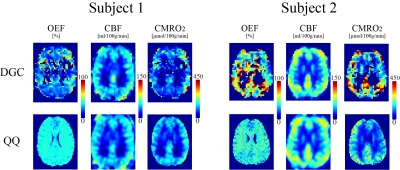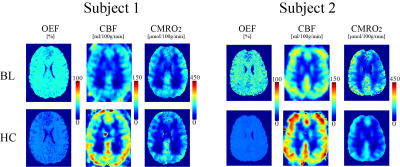Junghun Cho1, Yuhan Ma2, Pascal Spincemaille3, Bruce Pike2,4, and Yi Wang1,3
1Biomedical Engineering, Cornell University, New York, NY, United States, 2McConnell Brain Imaging Centre, McGill University, Montreal, QC, Canada, 3Radiology, Weill Cornell Medical College, New York, NY, United States, 4Radiology, University of Calgary, Calgary, AB, Canada
1Biomedical Engineering, Cornell University, New York, NY, United States, 2McConnell Brain Imaging Centre, McGill University, Montreal, QC, Canada, 3Radiology, Weill Cornell Medical College, New York, NY, United States, 4Radiology, University of Calgary, Calgary, AB, Canada
Comparison between dual-gas
challenge calibrated-BOLD and QSM+qBOLD (QQ) model provided similar OEF and
CMRO2 in healthy subjects. QQ does not require a gas challenge, and reveal 14%
CMRO2 decrease with hypercapnia compared to baseline.

